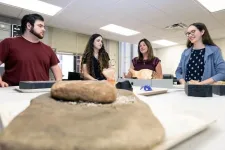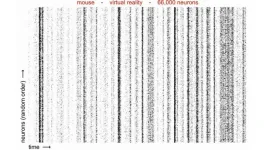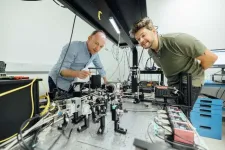(Press-News.org) Bacteria evolve rapidly in the human gut by sharing genetic elements with each other. Bacteriodales is a prolific order of gut bacteria that trade hundreds of genetic elements. Little is known, however, about the effects of these DNA transfers, either to the fitness of the bacteria or the host.
New research from the University of Chicago shows that a large, ubiquitous mobile genetic element changes the antagonistic weaponry of Bacteroides fragilis, a common bacterium of the human gut. Acquisition of this element shuts down a potent weapon of B. fragilis, yet arms it with a new weapon to which the strain that donated the DNA is protected. These weapons help the bacteria carve out niches in the tightly packed recesses of the gut.
Laurie Comstock, PhD, Professor of Microbiology and member of the Duchossois Family Institute at UChicago, and senior author of the new study, has been studying different antagonistic mechanisms of Bacteroidales and the way they transfer DNA for more than 10 years. “These organisms evolve rapidly by DNA transfers. It’s quite amazing,” she said. “We knew that some strains of B. fragilis couldn’t fire their weapons, but when we saw it was due to the acquisition of a large mobile genetic element, that’s when we knew we found something interesting.”
The study, “A ubiquitous mobile genetic element changes the antagonistic weaponry of a human gut symbiont,” was published October 24 in Science.
A spring-loaded, poison-tipped spear
Many Bacteroidales species can kill neighboring bacteria by producing toxins. Some of these toxins simply diffuse from the bacterial cell into the surrounding environment, killing nearby sensitive strains. Another weapon is the type VI secretion system (T6SS), which is a nanomachine containing a pointed, spring-loaded tube loaded with toxins. When it fires, it injects toxins directly into neighboring cells like a poison-tipped spear.
The Bacteroidales T6SS comes in three different types, or genetic architectures. One, genetic architecture 3 (GA3), is exclusive to B. fragilis and is very effective at killing other Bacteroidales species. The other two types, GA1 and GA2, are encoded by genes contained on large mobile genetic elements called integrative and conjugative elements (ICEs). These GA1 and GA2 ICEs are rapidly transferring between Bacteroidales species in the human gut throughout the world. However, scientists have yet to observe the same, lethal potency in GA1 and GA2 T6SSs as they have for the GA3 T6SS.
“The ICE containing the GA1 T6SS ICE is racing through human populations, and rapidly transferring to numerous Bacteroidales species in a person’s gut,” Comstock said.
Comstock’s team started studying natural B. fragilis isolates that had a GA3 T6SS or had both a GA3 and GA1 ICE. Those with both ICEs no longer fired the GA3 weapon and could no longer kill other Bacteriodales species. To show this was due to the addition of the GA1 ICE to these strains, they transferred the GA1 ICE into B. fragilis strains with only the GA3 T6SS and showed that the resulting new strains, or “transconjugants,” were similarly unable to antagonize other strains with their GA3 T6SS.
The researchers then deleted portions of the GA1 ICE to see which region of the 116 kilobase ICE was shutting off the GA3 weapon. They found that a portion of the GA1 T6SS region encoding the membrane complex of the GA1 nanomachine prevented GA3 T6SS firing.
Next, the team wanted to see how the strains would compete in the mammalian gut. They orally inoculated gnotobiotic (germ-free) mice with equal numbers of isogenic, wild-type B. fragilis (GA3 T6SS only) and the GA3/GA1 ICE transconjugant. The transconjugant quickly outcompeted the wild-type strain in the mice. The investigators went on to show that that this competition was due to antagonism using the GA1 T6SS, the first demonstration of potent antagonism by the GA1 T6SS.
“We didn’t know if the GA1 containing strain was going to be antagonistic, so we thought the progenitor GA3 strain would win that battle in the gut,” Comstock said. “But that was not what happened.”
Switching sides and going on defense
The most unexpected finding from this experiment was that in the mouse gut, the GA3 T6SS was not being made at all. They later showed that a gene carried on the GA1 ICE encodes a transcriptional repressor that shuts down transcription of the entire GA3 T6SS, allowing even better production of the GA1 T6SS.
The overall effect of the transfer of this DNA element has consequences for the gut microbial community. The Bacteroidales strains containing the GA1 ICE are killed by the B. fragilis GA3 T6SS, but if one of these strains can transfer their GA1 ICE into the attacking B. fragilis strain, they create a strain that outcompetes the progenitor B. fragilis strain. This new strain no longer targets the donor strain and can also use the GA1 T6SS to communally defend the ecosystem from invasion by other Bacteroidales strains.
Comstock plans to continue studying this diverse family of transcriptional repressors that are frequently carried on mobile genetic elements of the Bacteroidales and their effects in recipient strains.
“This family of transcriptional repressors can be inactivated when they bind specific ligands. We would love to identify the ligands in the gut that derepress their activity,” she said.
The study also showed that in the mouse gut, the GA1 ICE transfer occurred rapidly, helping the transconjugant become a large component of the of the population. This suggests that researchers creating synthetic consortia of bacteria for therapeutics need to account for the effects of genetic transfer.
“As bacteria are being selected for inclusion in consortia as biotherapeutics, it is important to safeguard against introducing anything that could be transferred into or out of these strains that might have deleterious effects,” Comstock said.
The study, “A ubiquitous mobile genetic element changes the antagonistic weaponry of a human gut symbiont,” was supported by the National Institutes of Health and the Duchossois Family Institute. Additional authors include Madeline L. Sheahan, Katia Flores, Michael J. Coyne, Rita C. Smith, and Anitha Sundararajan from UChicago; Leonor García-Bayona, currently at Stanford University; Maria Chatzidaki-Livanis, currently at Ohio University; Andrea Q. Holst from Chr. Hansen A/S, Denmark; and Blanca Barquera from Rensselaer Polytechnic Institute.
END
Gut bacteria transfer genes to disable weapons of their competitors
New research from UChicago shows how common gut bacteria tame their antagonistic neighbors by transferring genes that change their weapon systems
2024-10-24
ELSE PRESS RELEASES FROM THIS DATE:
A new hydrogel semiconductor represents a breakthrough for tissue-interfaced bioelectronics
2024-10-24
The ideal material for interfacing electronics with living tissue is soft, stretchable, and just as water-loving as the tissue itself—in short, a hydrogel. Semiconductors, the key materials for bioelectronics such as pacemakers, biosensors, and drug delivery devices, on the other hand, are rigid, brittle, and water-hating, impossible to dissolve in the way hydrogels have traditionally been built.
A paper published today in Science from the UChicago Pritzker School of Molecular Engineering (PME) has solved this challenge that has long ...
Bird study finds sons help their parents less than daughters because they’re scouting future prospects
2024-10-24
Male birds help their parents less than females because they’re too busy scouting for new places to live and breed, a remarkable new study shows.
The study, led by researchers at the Centre for Ecology and Conservation at the University of Exeter, examined the cooperative behaviour and movement patterns of social birds called white-browed sparrow weavers, which live in the Kalahari desert.
These birds live in family groups in which only a dominant pair breeds – and their grown-up offspring, particularly females, help ...
Wake Forest Institute for Regenerative Medicine (WFIRM) awarded up to $48 million to utilize body-on-a-chip technologies to study fibrosis-inducing chemical injuries
2024-10-24
The Wake Forest Institute for Regenerative Medicine (WFIRM) has been awarded an eight-year contract, valued up to $48 million from the U.S. Department of Health and Human Services (HHS) to support the utilization of cutting-edge body-on-a-chip technologies aimed at studying and developing potential treatments for sulfur mustard and other fibrosis-inducing chemicals. The program has been approved with an initial contracting commitment of approximately $18 million.
This contract represents a continued partnership between WFIRM and the Biomedical Advanced Research and Development Authority (BARDA), ...
Study offers ‘compelling evidence’ for continuous stroke care improvement
2024-10-24
Research Highlights:
A retrospective look at Get With The Guidelines® – Stroke registry data from 2003 to 2022 finds substantial and sustained improvements in acute stroke care among those in the quality improvement program.
Researchers found increased adherence to evidence-based stroke care translates to better clinical outcomes and, ultimately, more patients being discharged home or to a skilled nursing facility more quickly.
Overall, authors say the positive trends suggest concerted quality improvement initiatives can improve ...
Professor awarded NEH grant to advance anthropology research collections at Texas A&M
2024-10-24
Dr. Katie Custer Bojakowski, an instructional assistant professor in the Department of Anthropology at Texas A&M University and the director and curator of its Anthropology Research Collections (ARC), has been awarded a Preservation Assistance Grant from the National Endowment for the Humanities (NEH).
The NEH’s Preservation Assistance Grants program helps organizations protect their collections of historical and cultural items, making sure they remain available for students, scholars and the public. These grants help address risks to these collections, ...
New tool helps scientists spot patterns in mountains of data
2024-10-24
Neuroscientists have learned a lot – like which neurons and circuits are associated with different behaviors – by recording the activity of small sets of neurons.
But what happens when you record thousands of neurons at one time? Or when you want to figure out the role of neurons when there isn’t an obvious external catalyst or you’re not sure what you’re even looking for?
That’s where Rastermap comes in.
The new visualization tool developed by the Stringer and Pachitariu labs at HHMI's Janelia Research Campus helps ...
Glomerular filtration rate changes following UTI in children with vesicoureteral reflux
2024-10-24
About The Study: This cohort study uses data from the Children With Vesicoureteral Reflux trial to assess estimated glomerular filtration rate (eGFR) changes in participants with vs without recurrent urinary tract infections.
Corresponding Author: To contact the corresponding author, David S. Hains, MD, MBA, email dhains@iu.edu.
To access the embargoed study: Visit our For The Media website at this link https://media.jamanetwork.com/
(doi:10.1001/jamapediatrics.2024.4546)
Editor’s Note: Please see the article for additional information, including other authors, author contributions ...
Dandelion-shaped supernova and zombie star
2024-10-24
In 1181, a new star shone near the Cassiopeia constellation for six months before disappearing. This event, recorded as a “guest star” by Chinese and Japanese observers almost a millennium ago, has puzzled astronomers for centuries. It is one of a few supernovae to be documented before the invention of telescopes. In addition, it remained an “orphan” the longest, meaning that none of the celestial objects visible today could be assigned to it. Now known as the supernova SN 1181, its remnant has only been traced in 2021 to the nebula ...
Experts call for clear and concise regulation of exosome-based treatments
2024-10-24
Clinics that offer exosome therapies claim they have the ability to repair and regenerate tissues and treat inflammatory and other immune-related conditions in a noninvasive way. Now, a team of bioethicists and legal scholars from Japan is sounding the alarm on the urgent need for stronger regulations surrounding these unproven interventions. Their letter appears October 24 in the journal Stem Cell Reports.
“Administering these treatments to patients without scientific evidence or a clear ...
Zebrahub: New atlas tracks zebrafish development like never before
2024-10-24
When early cartographers undertook perilous expeditions to map unknown corners of the world with sextants, compasses, and hand-drawn diagrams, it’s unlikely they imagined that someday anyone with an internet connection would have access to a seamless view of the entire planet from the comfort of their own home. Today, pioneering scientists are working to create a similar experience for a much tinier, but no less important domain: developing embryos. The goal is to track and map the behavior of each and every cell working together to create an adult lifeform, and present that map in a clickable, ...
LAST 30 PRESS RELEASES:
The Ceramic Society of Japan’s Oxoate Ceramics Research Association launches new international book project
Heart-brain connection: international study reveals the role of the vagus nerve in keeping the heart young
Researchers identify Rb1 as a predictive biomarker for a new therapeutic strategy in some breast cancers
Survey reveals ethical gaps slowing AI adoption in pediatric surgery
Stimulant ADHD medications work differently than thought
AI overestimates how smart people are, according to HSE economists
HSE researchers create genome-wide map of quadruplexes
Scientists boost cell "powerhouses" to burn more calories
Automatic label checking: The missing step in making reliable medical AI
Low daily alcohol intake linked to 50% heightened mouth cancer risk in India
American Meteorological Society announces Rick Spinrad as 2026 President-Elect
Biomass-based carbon capture spotlighted in newly released global climate webinar recording
Illuminating invisible nano pollutants: advanced bioimaging tracks the full journey of emerging nanoscale contaminants in living systems
How does age affect recovery from spinal cord injury?
Novel AI tool offers prognosis for patients with head and neck cancer
Fathers’ microplastic exposure tied to their children’s metabolic problems
Research validates laboratory model for studying high-grade serous ovarian cancer
SIR 2026 delivers transformative breakthroughs in minimally invasive medicine to improve patient care
Stem Cell Reports most downloaded papers of 2025 highlight the breadth and impact of stem cell research
Oxford-led study estimates NHS spends around 3% of its primary and secondary care budget on the health impacts of heat and cold in England
A researcher’s long quest leads to a smart composite breakthrough
Urban wild bees act as “microbial sensors” of city health.
New study finds where you live affects recovery after a hip fracture
Forecasting the impact of fully automated vehicle adoption on US road traffic injuries
Alcohol-related hospitalizations from 2016 to 2022
Semaglutide and hospitalizations in patients with obesity and established cardiovascular disease
Researchers ‘listen in’ to embryo-mother interactions during implantation using a culture system replicating the womb lining
How changing your diet could help save the world
How to make AI truly scalable and reliable for real-time traffic assignment?
Beyond fragmented markets: A new framework for efficient and stable ride-pooling
[Press-News.org] Gut bacteria transfer genes to disable weapons of their competitorsNew research from UChicago shows how common gut bacteria tame their antagonistic neighbors by transferring genes that change their weapon systems





